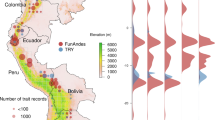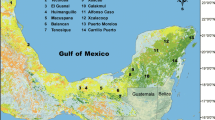Abstract
The relationship between gross morphological dispersal structures, growth habit, and weediness is reported for a worldwide sample of 5893 Compositae species from 18 regional floras. A significantly smaller percentage of annual species than perennial species has dispersal structures. Among species with dispersal structures, plumed types are more frequent in perennials while adhesive types are more frequent in annuals. Differences in the occurrence and nature of dispersal structures between perennial herbs, shrubs and trees were minor. Weeds are less likely to have well developed morphological dispersal structures than non-weeds. The data support the idea that dispersal in space may be more important for perennial or non-weedy plants than for annual and weedy plants.
Similar content being viewed by others
References
Baker, H. G., 1974: The evolution of weeds. — Ann. Rev. Ecol. Syst.5, 1–24.
Bentham, G., 1863–1878: Flora Australiensis: a Description of the Plants of the Australian Territory. — London: Reeve & Co.
Burrows, F. M., 1973: Calculation of the primary trajectories of plumed seeds in steady winds with variable convection. — New Phytol.72, 647–664.
—, 1975: Wind-borne seed and fruit movement. — New Phytol.75, 405–418.
Cabrera, A. L., (Ed.), 1963: Flora de la Provincia de Buenos Aires. — Instituto Nacional de Tecnología Agropecuaria.
Carlquist, S., 1974: Island Biology. — New York: Columbia University Press.
Cohen, D., 1967: Optimization of seasonal migratory behavior. — Amer. Natur.101, 1–17.
Cook, R., 1980: The biology of seeds in the soil. InSolbrig, O. T., (Ed.): Demography and Evolution in Plant Populations. — Oxford: Blackwell.
Correll, D. S., Johnston, M. C., 1970: Manual of the Vascular Plants of Texas. — Renner, Texas, Texas Research Foundation.
Dale, I. R., Greenway, P. J., 1961: Kenya Trees and Shrubs. — Nairobi, Buchanan's Kenya Estates in association with Hatchards, London.
Degener, O., 1946: Flora Hawaiiensis: the New Illustrated Flora of the Hawaiian Islands. 2nd ed. — Honolulu, Privately published by the author.
Ehrendorfer, F., 1965: Dispersal mechanisms, genetic systems, and colonizing abilities in some flowering plant families. InBaker, H. G., Stebbins, G. L., (Eds.): Genetics of Colonizing Species. — New York, London: Academic Press.
Frank, P., 1957: The Philosophy of Science. — Englewood Cliffs, N.J.: Prentice-Hall.
Gadgil, M., 1972: Dispersal: population consequences and evolution. — Ecology52, 253–261.
Gillespie, J. H., 1981: The role of migration in the genetic structure of populations in temporally and spatially varying environments. III. Migration modification. — Amer. Natur.117, 223–233.
Gleason, H. A., 1963: The New Britton and Brown Illustrated Flora of the Northeastern United States and Adjacent Canada. 3 vols. — New York.
Harvey, W. H., 1894: Flora Capensis: being a Systematic Description of the Plants of the Cape Colony, Caffraria & Port Natal, vol. 3. — London: L. Reeve & Co.
Hitchcock, C. L., Cronquist, A., Ownbey, M., Thompson, J. W., 1955: Vascular plants of the Pacific Northwest. Part 5. — Seattle: Univ. Washington Press.
Irvine, F. R., 1961: Woody Plants of Ghana. — London, Oxford: Univ. Press.
Laing, R. M., Blackwell, E. W., 1957: Plants of New Zealand. 6th ed. — Christchurch: Whitcombe & Tombs.
Lasser, T., (Ed.), 1964: Flora de Venezuela10. — Caracas: Instituto Botánico.
Levin, D. A., Kerster, H. W., 1974: Gene flow in seed plants. — Evolutionary Biology7, 139–220.
—, 1977: Clutch size in theCompositae. — InStonehouse, B., Perrins, C., (Eds.): Evolutionary Ecology, 215–222. — London: MacMillan Press Ltd.
Long, R. W., Lakela, O., 1971: A Flora of Tropical Florida: a Manual of the Seed Plants and Ferns of Southern Peninsular Florida. — Coral Gables, Univ. of Miami Press.
Merrill, E. D., 1969: A Flora of Manila. — Lehre: J. Cramer.
Munz, P. A., 1959: A California Flora. — Berkeley: Univ. Calif. Press.
Palmer, A. R., Strathman, R. R., 1981: Scale of dispersal in varying environments and its implications for life histories of marine invertebrates. — Oecologia48, 308–318.
Pulle, A. A., 1938: Flora of Suriname. — Amsterdam: J. H. de Bussy.
Ridley, H. N., 1922–1925: The Flora of the Malay Peninsula. — London: L. Reeves & Co.
—, 1930: The Dispersal of Plants Throughout the World. — Ashford, Kent: L. Reeves & Co.
Salisbury, E., 1975: The survival value of modes of dispersal. — Proc. Royal Soc. Lond. B188, 183–188.
Seigel, S., 1956: Nonparametric Statistics for the Behavioral Sciences. — New York: McGraw-Hill.
Sheldon, J. C., Burrows, F. M., 1973: The dispersal effectiveness of the achene-pappus units of selectedCompositae in steady winds with convection. — New Phytol.72, 665–675.
Shreve, F., Wiggins, I. L., 1964: Vegetation and Flora of the Sonoran Desert. — Stanford: Stanford U. Press.
Stebbins, G. L., 1950: Variation and Evolution in Plants. — New York: Columbia Univ. Press.
van der Pijl, L., 1972: Principles of Dispersal in Higher Plants. — Berlin: Springer-Verlag.
Vance, R. R., 1980: The effect of dispersal on population size in a temporally varying environment. — Theoret. Pop. Biol.18, 343–362.
Werner, P. A., 1979: Competition and coexistence of similar species. — InSolbrig, O. T., Jain, S., Johnson, G., Raven, P. H., (Eds.): Topics in Plant Population Biology. — New York: Columbia University Press.
Wiggins, I. L., Porter, D. M., (Eds.), 1971: Flora of the Galapagos Islands. — Stanford, Stanford U. Press.
Author information
Authors and Affiliations
Rights and permissions
About this article
Cite this article
Venable, D.L., Levin, D.A. Morphological dispersal structures in relation to growth habit in theCompositae . Pl Syst Evol 143, 1–16 (1983). https://doi.org/10.1007/BF00984109
Received:
Issue Date:
DOI: https://doi.org/10.1007/BF00984109




